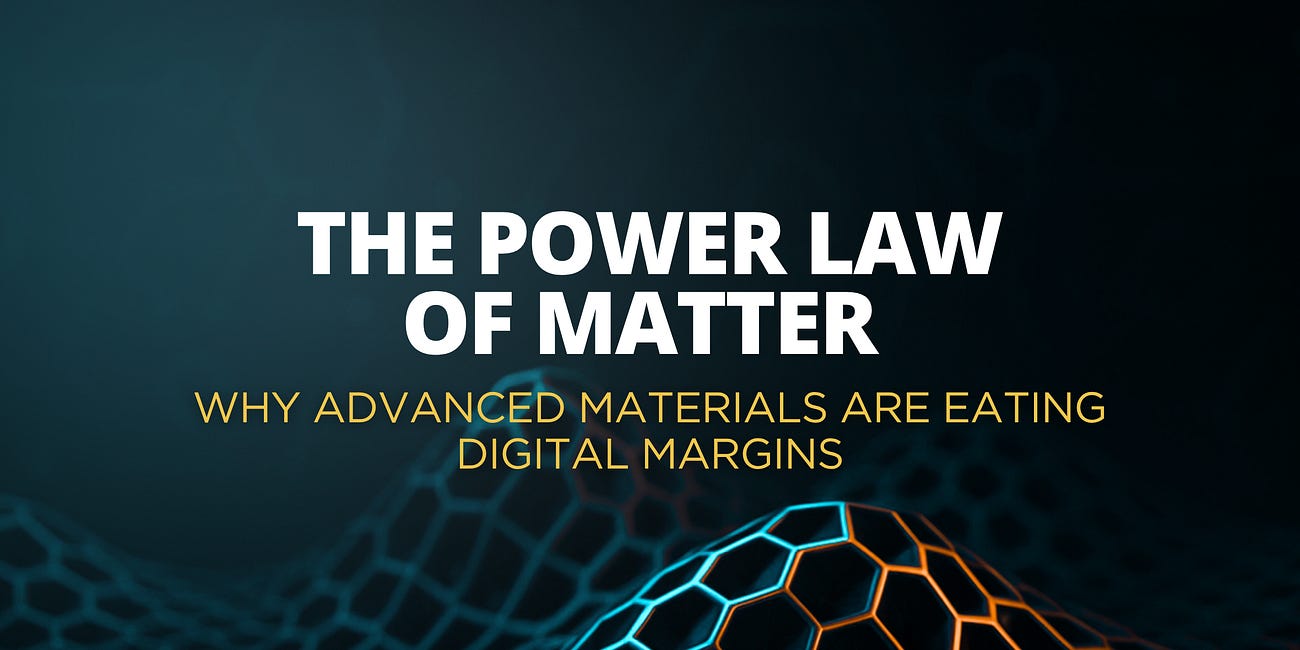Welcome to the 92nd edition of Deep Tech Catalyst, the educational channel from The Scenarionist where science meets venture!
If you’ve been following the debate around plastics, recycling, and new material innovation—but aren’t sure how these technologies translate into investable companies—this episode is your guide.
Today, we’re excited to welcome Joshua Speros, Investment Manager at BASF Venture Capital!
Together, we explore the future of plastics as both a scientific and industrial challenge—from the realities of closing the loop, to the economics of new polymers, to the milestones that matter when scaling from lab bench to pilot plant.
In this edition, we unpack:
How “cost parity” defines the market for new plastics—and when performance can justify a premium
Why Packaging, Automotive, and Healthcare rely on plastics today
Where customers pull beats technology push in building investable material startups
What a credible roadmap looks like from pre-seed to pilot plant and beyond
How sustainability becomes compelling when paired with cost savings and performance
Whether you’re a founder developing next-generation materials, an investor assessing the sector, or a scientist curious about commercial pathways, this conversation lays out what it takes to turn breakthrough ideas into industrially viable companies at the frontier of plastics.
Let’s dive in! 🧪
✨ For more, see Membership | Deep Tech Briefing | Insights | VC Guides
BEYOND THE CONVERSATION — STRATEGIC INSIGHTS FROM THE EPISODE
The State of Plastics in 2025
Plastics remain one of the defining materials of the modern economy. They appear in every domain—packaging, automotive components, textiles, medical consumables, and beyond. Yet the system through which they are produced and disposed of remains overwhelmingly linear.
Virgin production, still rooted in fossil-based feedstocks, supplies the market with vast quantities of material each year. Once used, most of it disappears into incinerators, landfills, or the environment. Despite decades of effort, more than ninety percent of the world’s plastic output is still not effectively recycled.
This linearity is not the result of indifference. It is a function of scale, complexity, and economics. Engineering plastics may last longer in use, but the majority of high-volume packaging plastics are consumed quickly and discarded just as quickly. The gap between production capacity and recovery infrastructure continues to widen.
Closing the Loop in Practice
The concept of “closing the loop” has become a central theme for industrial players and policymakers alike. At its core, it means creating reliable pathways to bring post-use plastics back into circulation, restoring them to the performance levels of virgin materials. Achieving that vision, however, depends heavily on the nature of the material stream.
Some cases are relatively straightforward. Polyethylene terephthalate (PET) water bottles, for example, are homogeneous, contain few additives, and are typically free from heavy contamination. They lend themselves to mechanical recycling that preserves much of the original material’s utility.
But beyond these simpler examples, the reality becomes far more complicated. Multilayer food packaging combines different plastics with adhesives, coatings, and sometimes even metallic layers. Many consumer plastics are contaminated with food residue, inks, or dirt. These streams resist straightforward processing and require more advanced approaches—chemical recycling, depolymerization, or hybrid systems that are still developing industrial traction.
The Problem of Perceived Value
The technical challenges are compounded by perception. Plastic has historically been valued only during its use phase. A bottle is valuable when it contains water; once emptied, it is seen as disposable. This stands in stark contrast to materials such as aluminum or copper, where intrinsic value drives well-developed collection and recovery systems.
Because post-use plastic is rarely treated as a valuable commodity, it is often handled in ways that further diminish its potential for reuse. Mixed waste streams, inconsistent collection standards, and low incentives leave recyclers working with materials that are costly to process and yield little economic reward.
Beyond Messaging: An Industrial Imperative
The effort to create a circular plastics system is often framed in aspirational terms, but its significance is fundamentally industrial. Treating plastics as single-use represents a profound inefficiency: valuable hydrocarbons are converted into high-performance materials, only to be discarded after minimal use. Replacing those materials with fresh virgin production compounds increases energy consumption and drives up long-term costs.
Closing the loop is therefore not a matter of branding. It is an operational challenge with direct implications for competitiveness, resource efficiency, and industrial resilience. The opportunity lies in reframing end-of-life plastics not as liabilities to be managed, but as feedstocks to be re-engineered into productive use.
The Power Law of Matter: Why Advanced Materials are Eating Digital Margins
From SaaS Logic to Commodity Logic. From advanced materials in photonics to fusion energy — the real profit pools are moving back into the atomic layer.
Market Realities and Economic Boundaries
When it comes to plastics, the first and most immovable reality is cost. Commodity plastics such as polyethylene or polypropylene are produced at enormous scale, with razor-thin margins and entrenched supply chains.
For anyone attempting to introduce a new material into these markets, cost parity is not optional—it is mandatory. Customers purchasing plastics for packaging or other high-volume applications have little tolerance for premiums. In most cases, a new material that costs more simply will not be considered, no matter how compelling its technical features may be.
This unforgiving baseline does not mean there is no room for innovation. It does mean that new entrants must either achieve price equivalence or identify specific applications where differentiated performance justifies a premium.
Even then, that premium is constrained. A rough boundary exists: more than double the cost of the incumbent material is rarely tolerated, and even a twofold premium is feasible only in specialized niches.
Premiums in Performance-Driven Markets
The rare exceptions to this rule can be found in segments where performance carries disproportionate weight. Athletic footwear, for instance, is an example where a consumer may pay hundreds of dollars for a pair of shoes. In such cases, an advanced polymer that delivers superior durability, elasticity, or comfort may justify a higher material cost within the final product’s overall economics.
But these situations are limited. In most industrial and consumer applications, margins are not sufficient to absorb a steep increase in material costs. Startups and research-driven founders often underestimate how narrow the window is for capturing a premium price. The majority of the market will only respond if the economics align with the incumbent baseline.
3 Industrial Sectors Deep Tech Founders Should Consider
Cost is only one side of the equation. Demand dynamics also matter. Over the last decade, several sectors have emerged as major engines of plastic consumption.
Packaging
The global rise of e-commerce and on-demand delivery has led to a proliferation of packaging material. Every item that reaches a consumer’s doorstep requires protective layers, tapes, films, and labels—most of which incorporate plastics. With a growing middle class in many regions, packaged foods and consumer goods have become ubiquitous, further driving demand.
Automotive
Beyond the shift to electrification, manufacturers continue to pursue lightweighting strategies. Reducing metal content lowers production costs and increases efficiency. Plastics play a critical role, from adhesives that replace rivets and bolts to cable jacketing and electrical connectors. Each year, more cars are produced than the year before, and each one contains more plastic components.
Healthcare
The expansion of medical infrastructure worldwide, amplified by global pandemics, has accelerated the use of plastic consumables and packaging. Syringes, diagnostic tools, sterile wraps, and protective equipment all rely on polymers designed for safety and performance.
Growth Outpacing Infrastructure
The common denominator across these sectors is that consumption is rising faster than the systems designed to manage post-use material. Even in advanced economies, collection and recycling infrastructure struggles to keep up. In many developing or rapidly industrializing regions, the gap is even more pronounced.
The outcome is predictable: year after year, more plastics are produced, consumed, and discarded, with little progress toward effective recovery. For founders and investors, this imbalance is both a challenge and an opportunity.
The Commercialization Dilemma: Tech Push vs. Market Pull
For startups and early-stage founders, the lesson is clear. Introducing a completely new polymer is possible, but the barriers are formidable. The costs, the regulatory hurdles, the scale-up challenges, and the need for established market access all converge to make this a rare success story rather than a reliable pathway.
The Limits of Pure Technology Push
Scientists and polymer chemists are naturally inclined toward invention. With the ability to synthesize novel materials, the instinct is to search for applications—finding the “nails” once the “hammer” is in hand. This technology-push model has generated remarkable advances at the lab scale, but its record in creating investable businesses is mixed at best.
Markets do not adopt materials simply because they are new. They adopt them when they solve problems in ways that align with cost, scale, and existing supply chains. A novel polymer may demonstrate fascinating properties, yet without a defined use case and a willing customer base, it risks becoming an academic exercise rather than a commercial venture.
The Weight of Market Pull
Customer-driven development, by contrast, starts with a problem statement. In plastics, that may mean a lightweight composite for automotive applications, a more durable connector material, or a film that meets strict regulatory thresholds for food safety. With a clear target, the process of material innovation becomes oriented toward practical outcomes, not just scientific novelty.
Investors tend to favor this model because it reduces market risk.
A founder who begins by understanding industry pain points—speaking with OEMs, tier-one suppliers, or packaging giants—has a stronger chance of aligning technical development with real demand. While technology-push approaches may yield breakthrough science, market-pull approaches are more likely to yield investable companies.
Building an Investable Timeline: From Lab to Pilot Plant
Pre-Seed: Defining the Foundation
At the earliest stage, the priority is clarity. Founders must define the minimum viable product with precision: what exactly is being made, what are its properties, and how could it be positioned in the market? The quantities available may still be measured in grams, but the conceptual framework has to be solid.
At the same time, early conversations with potential customers are essential, not in the form of promises or sales pitches, but as learning engagements.
Speaking with automotive suppliers, packaging manufacturers, or medical device companies helps to refine the understanding of product–market fit.
The objective is not revenue at this stage, but alignment: does the technology address a genuine industry problem?
Seed: From Proof of Concept to Industry-Relevant Testing
Moving into the seed stage, the task is to produce enough material for relevant tests. A laboratory sample is no longer sufficient; industry expects validation under conditions that mirror real-world use.
That might mean tensile strength testing for automotive composites, barrier property testing for packaging films, or durability testing for medical components.
Quantities remain modest, but the difference is critical. When potential partners can see data generated from their own protocols—or at least from recognized industry standards—the credibility of the project increases substantially. This is also the stage where initial traction with partners can begin, setting the stage for more formal relationships.
Series A: Scaling to Kilograms and Building Partnerships
By the time a company approaches Series A funding, the bar rises. Investors and customers alike expect to see production at a kilogram scale, ideally reaching into the hundreds of kilograms.
At this point, the material is no longer a scientific curiosity; it is something that can be processed, tested, and evaluated by potential buyers in realistic conditions.
Partnerships become critical here.
Sectors like automotive and aerospace have notoriously long qualification timelines, often stretching for years. Startups that align with established suppliers or corporations gain access to existing customer relationships and programs, effectively accelerating their path into the market. Without such alliances, the road can be prohibitively long.
Series B: Pilot Plants and Offtake Agreements
By Series B, the goal is to transition from laboratory and tool-based production to pilot-scale facilities. At this stage, output must be measured in tons rather than kilograms. Customers evaluating a new polymer or additive will not rely on lab reports alone. They want to handle the material themselves, run it through their processes, and verify its performance in-house.
For a startup, this means not only scaling production but also securing the regulatory approvals required for the intended application. Whether it is automotive safety standards, food-contact certification, or medical compliance, these hurdles are as critical as the material science itself.
The ultimate objective at this stage is to move beyond exploratory discussions into formal commitments. A memorandum of understanding is a start, but offtake agreements (even if limited to niche markets) signal that the material has a clear path to revenue. That, in turn, supports further investment and paves the way toward commercial-scale deployment.
Timing and Credibility
Across every stage, timing is crucial. Approaching potential customers too early risks creating false expectations or disappointment when volumes cannot be supplied. Approaching too late risks missing windows of opportunity or being dismissed as irrelevant. The art lies in engaging as a learning partner during the early stages, and only positioning the material as a solution once production volumes and reliability make that claim credible.
Economic Expectations and Investor Lens
The Margin Benchmark
Across the plastics industry, margins vary widely depending on application and scale. Commoditized, high-volume materials such as polyethylene operate on thin margins, while specialized, high-performance polymers can capture more favorable economics.
Averaged across the sector, expectations tend to cluster around a 20% margin. This figure is not an absolute rule, but it provides a useful reference point for both founders and investors.
For entrepreneurs, the implication is straightforward: any proposed business plan must demonstrate unit economics that are credible within this range. Margins significantly below that threshold raise questions about long-term viability, while projections far above it risk being dismissed as unrealistic.
Commodities Versus Niche Applications
The distinction between commodity and specialty markets is critical. In commodity spaces, scale is everything. Success depends on producing enormous volumes at razor-thin margins, an approach that is typically out of reach for startups.
In contrast, niche applications—where performance characteristics justify a premium—can support healthier margins. Here, differentiation matters more than sheer volume.
Understanding where a new material fits along this spectrum is essential. A polymer targeting packaging films will be judged differently from one targeting aerospace components. The former must meet cost parity; the latter may be able to command a higher price, but will face extended qualification timelines and technical scrutiny.
Investor Expectations
From an investor’s perspective, the appeal of a plastics-focused venture lies not only in the material itself, but in the pathway to scale. They look for three elements above all:
Credible Economics: Evidence that the unit economics, including margins, align with industry norms.
Scaling Milestones: A clear timeline showing how the company moves from laboratory production to ton-scale output, with each stage de-risked through partnerships and customer engagement.
Market Pull: Demonstrated demand from potential customers, ideally in the form of pilots, letters of intent, or early offtake agreements.
What investors do not want to see is a technology without a market, or projections that assume buyers will accept steep premiums indefinitely. Industrial buyers are pragmatic, and investors must be equally pragmatic in their assessment of potential returns.
The Industrial Lens
Ultimately, the plastics sector is not a domain for speculative enthusiasm. It is a field defined by scale, cost, and operational execution. Founders who understand these realities—and who position their companies with credible economics, disciplined scaling, and evidence of market pull—are the ones who attract serious capital.
For those capable of navigating this landscape, the rewards are significant. Plastics remain central to the global industry, and the demand for better solutions is only increasing.
But the path to building an investable company lies not in bold claims; it lies in disciplined execution and an industrial logic that investors and customers alike can trust.
Buffett in the Build Era. If AI flattens “value,” deep tech becomes the edge & more... | Deep Tech Briefing Vol. 79
Discover Our Weekly Intelligence on Deep Tech Private Markets.













